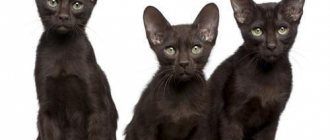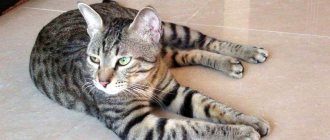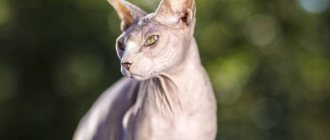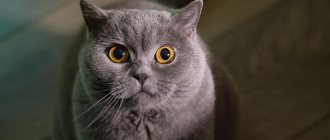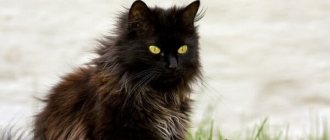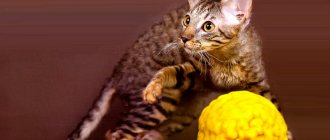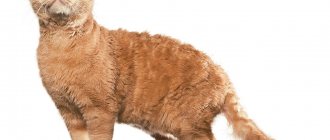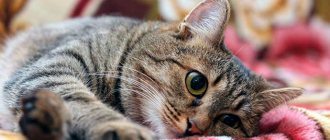Video
* We invite you to watch a video about the Asher . In fact, in front of you is a playlist in which you can select and watch any of 20 videos about a given cat breed by simply clicking on the button in the upper right corner of the window. In addition, the material contains quite a lot of photos. By looking at them you can find out what Asherah looks like.
Rate the material!
[Total votes: 0 Average: 0]
Asher cats are incredibly cute and adorable creatures. They depend on their owners and are practically no different from domestic cats. However, Asher cats are a real conundrum because not everyone agrees that such animals even exist. And why this happens, you will learn from this publication.
Features of care
This breed of cat is no different from other representatives of the cat world in terms of care. She, like an ordinary domestic short-haired cat, requires standard hygiene procedures:
- periodic bathing using mild shampoo - Ashera is not afraid of water, so there should be no problems in this case; You should definitely bathe such a large cat in a spacious bathroom;
Important! After water treatments, it is advisable to wipe the animal’s body dry and keep the pet away from drafts for an hour - this will help protect it from colds!
- cleaning the ears and eyes - it is convenient to use cotton swabs for this;
- timely trimming of nails using special nail clippers - this procedure will help keep the upholstery of upholstered furniture intact.
This article will tell you more about how to properly wash a cat.
History of the origin of Asher
The Ashera cat was a type of hybrid cat sold by the infamous Lifestyle Pets company. Representatives of the brand claimed that the hybrid cat breed was something between an African serval, an Asian leopard cat and a domestic cat. The truth, discovered through DNA testing, was that the Asher cats were simply Savannah cats purchased from other breeders and resold later.
The Savannah cat is a famous hybrid cat breed that was produced by crossing a Serval cat with a domestic cat. They usually sell for significantly less than Asher cats. So Lifestyle Pets simply bought Savannah cats and then resold them as Asher cats.
Fun Fact: The authenticity of the breed has been questioned by Pennsylvania cat breeder Chris Shirk of Cutting Edge Savannahs, who told the San Diego Union-Tribune that several cats sold by Allerca and labeled "Asheras" were actually bred by him as another hybrid, the 'Savannah'. F1' (First generation Savannahs).
The Savannah is a cross between a domestic cat and a Serval, a large, medium-sized, long-eared African cat. The unusual cross became popular among breeders in the late 90s, and in 2001 the International Cat Association accepted it as a new registered breed.
Breeding
Ashera was initially positioned as a unique breed and did not involve mass breeding. Breeders from the Lifestyle Pets company argued that otherwise the cats would no longer meet the requirements of exclusivity and would become ordinary house purrs.
Asher cats are not subject to mass breeding
Such statements were partly true. Because the savannah, which was presented by resourceful entrepreneurs as a new breed, also loses its qualities with each generation.
In total, four tribes of descendants originating from the wild serval are considered valuable among the Ashera:
- F1 are direct descendants of an African predator and a domestic cat, the genome consists of half wild genes.
- F2 is the second, less valuable generation with 30% of Serval genes in the blood.
- F3 are the least valuable descendants with no more than 10% wild genes in the genome.
- F4 - degree of relationship requires an infusion of Serval blood to preserve the breed data.
Since certain difficulties arise with breeding, professional breeders should carry out breeding activities. That is why Ashera and Savannah are not purchased for the purpose of obtaining offspring, but only for decorating the home.
The pregnancy of Asher cats lasts 68–72 days, and 3–4 kittens are born in a litter. Which means reserving pets in advance for further purchase.
Kittens at the age of two months are required to be sterilized. However, until the fourth generation, males are sterile, which is why females are valued higher. But it is recommended to castrate pets for another reason. Ashera, as a true descendant of wild servals, strives to regularly mark the boundaries of his territory by marking everything around him.
It is important to remember that 12 hours before surgery you need to put your pet on a strict diet, giving only water to drink. Within a month, deworming is carried out and ectoparasites are removed.
After the operation, the cat is gradually removed from anesthesia with the obligatory presence of a veterinarian. After all, this hybrid breed may not tolerate the effects of medications well.
The day after returning from the clinic, the cat is fed in small portions and as often as possible - every one and a half to two hours. In addition, the animal should not be allowed to move without the supervision of the owner due to possible disturbances in coordination of movements.
Ashera - description of the breed
The Asherah cat is the largest breed of cat bred. Their tall and muscular build gives them greater size than their actual weight. Males of F1 hybrids are usually the largest. F1 and F2 hybrids are the largest due to the stronger genetic influence of the African serval ancestor. The size of the breed is highly dependent on generation and gender.
Early generation Ashers can weigh 8kg or more, with the heavier weight usually attributed to castrated F2 or F3 males, although this is not the norm. Due to random factors in the genetics of hybrids, size can vary significantly even within the same litter.
It is a large, sleek and very muscular cat with a thick tail that is carried low. The wild appearance is enhanced by her characteristic dense and luxurious spotted or marbled coat.
The distinctive features of the Ashera are:
- Wide head;
- The rounded, elongated ears are widely spaced and pubescent along the inner edge;
- Oblong-curved body;
- Elongated slender neck;
- Extended legs;
- The round eyes are set wide apart, with a yellowish-golden iris;
- Ears;
- The tail is thick, tapering to a black tip.
Ashera is the largest representative of domestic cats. The tall and slender body looks impressive. The cat can reach a length of one meter and weigh up to 14 kg. Size varies by generation and gender. These cats are calm, curious and active. The breed's intelligence level is high. They love to swim, run outdoors and play games.
Popular Asher colors
The Asherah is a well-known hybrid breed created by crossing a domestic cat and a large wild cat, the serval. Asher's cat colors should be reminiscent of her serval cat ancestor, acceptable colors being brown, silver, black and smoke. The Serval cat has a bright oily golden base coat with hard black spots. This golden color is a shade of the brown spotted tabby and should be registered as a brown spotted tabby.
The Inhibitor gene eliminates the yellow pigment in the marked parts of the coat, but does not affect the unmarked areas. An inhibitor gene can suppress all or little of the yellow pigment, causing some cats to have a washed-out brown color. This yellow pigment that shows through is called “tarnish.”
There is also a non-standard (undesirable) color. Such colors tend to be recessive or dilute colors that stem from internal heritage.
These include:
- Cinnamon – recessive;
- Chocolate is recessive;
- Fawn - diluted with cinnamon;
- Blue - diluted black;
- Lilac - diluted chocolate.
All colors must pass through a breed committee to be accepted by TICA. The colors currently adopted should resemble the ancestor of the African Serval cat. Each time a color is accepted, breeders evaluate how it will genetically affect the breed. For example, when the color silver was adopted, it meant that it suppresses the brown color.
Character and habits of Asher
Cats are calm, curious and active. The intelligence level of this breed is high. They love to run outdoors and play games. The typical Asherah is very energetic. They want to be involved in everything. They will be offended when they don't get what they wanted. “Vandalism” is the price you pay for a bored, energetic cat that lacks proper mental stimulation. A bored Asher cat looks like an unhappy baby. Asher owners love the intelligence that this wonderful breed possesses.
An often noted feature of the savannah is its ability to jump. They are known to jump everywhere, on doors, refrigerators, cabinets, etc. Some Savannahs can jump to a height of about 2.5 m from a standing position. Ashers are very inquisitive. They often learn to open doors and cabinets. Anyone purchasing an Ashera will need to take special precautions to prevent the cat from getting into trouble.
Ushers are known for their loyalty. They will follow their owners around the house. They can be easily taught to walk on a leash. Some individuals are sociable and friendly with new people, cats and even dogs, while other individuals may run away or hiss aggressively when a stranger appears.
Interesting fact: There are three factors that influence the behavior of an Asher cat: origin, generation and socialization. Nature is ancestry, and generation and nurture are social adaptation. The development of the Asherah (Savannah) breed is still in its infancy, and most cats have a wide range of behaviors.
Many ushers are not afraid of water and can even dive into water. Some owners shower with their ushers. Presenting a bowl of water for drinking can be a problem because... some animals will immediately begin to "scoop" all the water out of the bowl until it is empty, using their front paws.
Another quirky feature of the Ashera is that it fluffs the base of its tail as a greeting. This behavior should not be confused with the fluffing of fur on the back and along the entire length of the tail, which the Ashera does when afraid. Ushers often flick or wag their tails in excitement or pleasure.
Character
Ashera is a cat with excellent intelligence. They get along well with all family members, including children and other pets. Their sociability, affection and tenderness allow them to find a place in the heart of every household member. These cats are very active, love to run and play, so when keeping them it is better to stock up on toys, and it is better to promptly remove things that they can spoil in an inaccessible place. Their games are often associated with hunting actions - chasing prey, tracking, hiding in a secluded place for the purpose of attack. They got all this from their wild relatives, the servals.
These animals are characterized by curiosity and activity, so they definitely need walks. They, like dogs, can calmly walk with their owner on a leash and learn some commands. During the walk, the curious and observant Ashera explores the territory, sniffing every bush, stone and post.
Ashera is distinguished by devotion and affection for his owner, he is next to him almost everywhere, participating in all matters. Despite their wild ancestors, these cats never show aggression, but it is important that they are raised and socialized around people from childhood. They, like dogs, need to be raised, explaining in a stern voice what is possible and what is not, they must feel authority in the owner and understand that he is in charge. But screaming and hitting them is not recommended, as you can forever lose the trust of this animal. Ashera has a very developed intellect and intelligence, so it is enough to tell them for them to understand that this is prohibited.
These cats are very partial to water, they love to swim both in the bathtub and in ponds, and can entertain themselves for hours by catching toys from a basin filled with liquid. To them, it reminds them of the fishing that their serval relatives do in the wild. But it’s better to put vases with water and flowers away so that they don’t end up broken into pieces.
Interesting facts about ushers
The most interesting fact about the Asher is that such a breed does not exist at all. Ashers are improved cats selected from the savannah population. And since the Savannah is a relatively new breed, the exact criteria for its color, behavior and shape have not yet been developed. Therefore, confusion often arises. The Ashara has become a popular pet due to its interesting and exotic appearance.
Interesting facts about the breed include:
- Ashers are smart and cunning and love to be on high ground. They can be found on kitchen cabinets, refrigerator tops, and interior cabinets;
- It is quite common for Asher to play in water. Therefore, toilets should be kept closed, although the animal may learn to open them;
- Sounds you may hear from an Ashera include chirping, meowing and hissing sounds;
- The Australian Federal Government has banned the import of Asheras into Australia because the larger cats potentially threaten the country's native wildlife species. A government report into the proposed cat import warns that the hybrid breed could introduce improved hunting skills and increased size of wild specimens, putting native species at risk.
It quickly became apparent that the Savannah Asherah had some canine qualities. This led to an increase in the popularity of the breed. An Asher cat becomes attached to its owner and will follow him or her around like a dog.
Asher cats are also excellent swimmers. Asher breeding became popular in the late 1990s. The International Association accepted the breed in 2001. Less than ten years later, the Savannah cat was recognized by TICA as a champion breed.
Breed standards
The large domestic cat Asher has certain qualities of the breed that regulate the appearance and proportions of the animal. Almost identical requirements apply to her relative Savannah.
The Asher breed is distinguished by its height - an adult cat can reach a meter in height. Moreover, the animal has a narrow, elongated, somewhat disproportionate body with long legs and a tail. Cats are very elegant and graceful. The maximum weight of a cat is 12 kg, a cat is 14 kg.
The animals have a small, elongated head. The ears are wide at the base, narrowing and rounding towards the tips. Eyes are most often of two colors - olive and yellow.
The coat is short, smooth, and lies close to the body.
The color depends on the type of cat:
- The Royal Asherah is the most rare. The variety is distinguished by a small number of bright golden spots on the skin.
- The hypoallergenic variety implies a fairly variegated color on a sandy or light brown background. Ashera's wool contains a minimal amount of protein that causes allergic reactions.
- Snow Ashera is very similar to a snow leopard. The silver coat and numerous dark spots make the cat unique.
- The usual type of breed provides the classic leopard color (sparse stripes instead of spots are acceptable).
Savannah cat character
The Ashera cat breed is distinguished by its amazing friendliness and sociability. They are able to get along with any other animals, including rodents and birds. Cats into old age retain the playful disposition of a kitten and the devotion of a dog.
Cats can be trained: they quickly remember commands and happily carry them out.
You can walk the streets with the cat; he loves water and can play with a ball in the company of his owner.
However, this type of character also has its drawbacks - pets of the Asher breed need to be given a lot of time. Without attention, the animal quickly becomes restless and reacts worse to its owner.
Asherah kittens may react inappropriately to various stimuli, such as loud music, touching, and intrusive attention from strangers.
Health and life expectancy
The cat of the Ashera breed has excellent health. However, its digestive tract is quite delicate. Therefore, you will have to choose your diet very carefully and prepare food for your cat correctly. In addition, the pet needs a lot of space to play; limited space can harm the cat’s cardiovascular and musculoskeletal systems.
If all maintenance rules are followed (proper cat nutrition, care, regular medical procedures), cats can live up to 20 years. However, any violation significantly shortens the pet’s life.
Care and hygiene
Ashera is an unpretentious breed in care and maintenance. The cats are short-haired, shed very lightly and do not develop tangles. They should be brushed once a week with a gentle brush. You can bathe cats no more than once a month (less often is better), only after obvious contamination that causes discomfort.
Many owners suffer from their pets’ love of sharpening their claws on walls and furniture, but this animal’s claws should be trimmed only in extreme cases using a special nail clipper. It is better to accustom the animal to the scratching post and walk it more often.
Asher's diet
Dry food, even the highest quality, is strictly prohibited for cats of this breed. Ashers have special digestive abilities and can eat ready-made food only as an addition to the main diet.
It is important to feed a luxurious animal with natural meat and fish, for example, veal, turkey, and marine fish. You can also add stewed vegetables and bird eggs to your diet.
To prevent damage to the animal’s delicate digestive tract, it is necessary to give meat after removing the bones. Before serving to the animal, purchased products must be frozen for three days, and then thawed and treated with boiling water. It is better to feed your cat food cut into small pieces.
Pros and cons of usher
You should take an honest look at your life and possibilities, and then decide whether it is worth getting such a pet, and whether it will fit into your life. Because people overestimate their abilities, the Asherah can find itself in a difficult position. Some studies show that changing a place of residence and parting with its previous owner has a bad effect on the animal's condition, and some of them cannot survive this trauma.
Learn all the pros and cons of the Asherah so you have a clear understanding of what to expect when you bring home this exotic cat.
Pros:
- Ashera (savannah) is a type of cat with a very striking appearance;
- They are loyal, loving and playful pets. Very attached to their owners;
- Can walk safely on a leash. Socialized individuals relate well to children and other animals;
- They are an exotic wildcat hybrid, so they are less domesticated. People adopting this unique animal must be active and devote enough time to playing with the pet;
- This is a stately cat of large size.
Minuses:
- Once the Ashera is left alone in the house, it demonstrates to its owners that this cat is much more wild than typical breeds. Therefore, it is difficult for novice owners who have been away from home for a long time to cope with it and many ushers end up in a shelter. This is not very good for an intelligent animal that needs to be active;
- They can spoil things and not necessarily intentionally. Things simply break down in their quest to explore the world around them. The closer they are to their ancestor, the more unpredictable their behavior;
- Because they do not have a long history of domestication, their hunting instinct is very keen and, due to their size, they rarely miss small prey;
- If you have small children or many responsibilities, the Asherah will become jealous;
- Say goodbye to all your plants, knick-knacks or pillows. Now everything belongs to the cat.
Asher Breeding
Since Ashers are produced by crossing a Serval and a domestic cat, each generation is marked with a serial number.
The F1 generation Asher is extremely difficult to produce due to the significant difference in gestation time between the Serval and the domestic cat. This period lasts 75 days for a serval and 65 days for a cat. Pregnancies are often terminated. In addition, servals can be very picky in their choice of partners and are often reluctant to mate with a domestic cat.
Savannah cross products may also be referred to (SV is the TICA code for the Savannah breed), in addition to the branch number. The Savannah numbers branch also has a letter designation referring to the SV-to-SV breeding generation. The designation "A" means that one parent is a Savannah and the other is an outcross. "B" is used when both parents are Savannahs, with one of them being "A".
Fun fact: Asherah is named after the goddess of the same name. This breed was deceptively brought into the market through fraud. The results of DNA tests confirmed that Asherah cats are Savannah cats.
The designation "C" is when both parents are Savannahs and one of them is a "B". F1 generation Savannahs are always "A" since the father is not a domestic cross (the sire is a serval). Generation F2 is either "A" or "B". The F3 generation is either "A", "B" or "C". The F4 generation is the first generation that can be a cat.
History of the breed
In 2007, the biotechnology company Life Style Pets announced the creation of a new breed of cat - the Asher. The breeders claimed that this animal was created by them by crossing the genes of an Asian Bengal , an African Serval and a domestic cat.
Later it turned out that the creator of the ashera simply fabricated the data. Shortly before this sensation appeared, a false breeder purchased several Savannah kittens from the nursery of a certain Chris Shirk.
Using all his abilities, the newly minted breeder identified himself as the creator of a new unique breed and launched active advertising activities around it. Chris Shirk saw a photo of an exclusive animal and immediately recognized it as one of his pets.
According to the statement of the Ashera's real owner, US Fish and Wildlife conducted a DNA test in 2008, the result of which showed that this cat is a typical representative of the Savannah breed.
The world saw these animals for the first time in the 80s of the 20th century, and their ancestors were indeed the domestic Bengal and the African serval, the first of which was the result of crossing a wild Bengal and an ordinary domestic cat.
The breeder's statements were very close to the truth, but he was not the creator of the breed. This whole story is the official version. It is quite confusing and it was very difficult to get to the truth.
The only indisputable fact at that time was the origin of the animal: it was a hybrid that descended from wild African and domestic cats.
The Asherah is the largest domestic cat in existence.
The exotic appearance and size, comparable perhaps to the Maine Coon , appealed to many, and the Asher cat became one of the most desirable pets almost all over the world.
The mini-cheetah with its magnificent spotted color and natural charm became a worthy competitor not only to other domestic cats, but also to dogs, since representatives of this breed allowed their owners to walk them on a leash.
Caring for Ushers
The philosophy of raising an Asherah is to make your pet what you make it to be. Providing proper daily care and mental stimulation will lead to the development of a healthy, well-adjusted animal into adulthood.
If you are planning to get an Asherah kitten, you will need to obtain the necessary care items and choose a room for keeping. As a cat owner, you also need important details on how to ensure proper exercise. Asher kittens are lively and curious, which can lead to serious trouble if you don't take the necessary precautions.
What to do first:
- Hide all wires;
- Add latches on cabinets;
- Remove the door handles.
Quarantine is a time interval of 2-3 weeks of personal individual communication with the new owner. A rushed adoption process can result in a fearful, moody, and unsure pet. Quarantine should be in a medium-sized room. This room should be ideal so that the kitten is not too confined so that the kitten does not feel threatened.
Remember that your kitten requires a visit to the veterinarian's office for vaccinations. Quarantine is also an ideal time to strengthen habits.
When you take your kitten home, you should follow several rules:
- Be calm when you bring your kitten home;
- Place the container with the pet on the floor and let the kitten come out on its own;
- To encourage your kitten to come out for the first time, coax it with a toy;
- Keep the kitten in a small room and then let him run around the house more;
- Sit on the floor, at kitten level, to play and interact with him.
Buy an Asher cat
It is possible to purchase a kitten of the Asher breed only in specialized nurseries, which in Russia, the largest country on the planet, can be counted on the fingers of one hand.
What to pay attention to
When purchasing, the first thing you should do is pay attention to the appearance of the animal. Kittens should be active and playful. Take the kitten in your arms, it must be socialized and behave adequately with humans. Feel the Asherah's belly, they have a weak gastrointestinal tract, so the absence of bloating is important. The kitten should be moderately well-fed, without excess discharge from the tear ducts, ears, nostrils or genital area. It must be clean without any unpleasant odors.
So, when the external inspection has been completed, ask for documents certifying the accuracy of the breed. It is also important to ask for documents from the parents and their medical records to check for the absence of genetic defects that could be passed on to the baby. Study the vaccination card.
It is also worth paying attention to the very conditions of keeping animals in the nursery. Often offended cats can be vindictive towards their future owners, which is especially dangerous given their large size. Cats that have been poorly cared for suffer from decreased immunity and, as a result, get sick more often. Considering the price of the animal, this should not happen a priori.
In licensed nurseries, the buyer is given a guarantee of the pet’s health for a period of one year, as well as after-sale veterinary care. During the purchase process, it is better to conclude an agreement signed by both parties, which will stipulate that the seller is obliged to carry out all the necessary vaccination and treatment measures against parasites before handing over the cat.
Asher kitten price
Despite the strange conditions of acquisition, the price of Ashera grew inexorably as there was a queue of people wanting to purchase it. People paid to reserve a kitten with a deposit of at least $6,000. After which, only when the kittens reached 12 weeks of age, the potential buyer could choose a pet for himself. Kittens were handed over only when they reached one year of age, supposedly at this point the animal undergoes full socialization, forming its character.
At the moment, an Ashera kitten costs from 20 to 27 thousand dollars, depending on its gender and purpose of purchase.
They sell only sterilized animals to ordinary people, selling potential successors to the breed only to specialized premium nurseries, since, according to breeders, crossing Ashera with any other type of cat can lead to the loss of her docile nature. And this promises sad consequences for those who find themselves next to her. In terms of rubles, a kitten can be bought for an amount ranging from 700 thousand to 1 million 750 thousand rubles.
Sources:
https://simple-fauna.ru/pets/cats/cat-breed/ashera/
https://lapkins.ru/cat/savanna-ashera/
https://aroundpet.ru/vneshnost-koshki-porody-ashera-opisanie/
Asher diet
We suggest eating a properly balanced pre-cooked or homemade raw diet. Providing a balanced raw diet is key. A properly balanced diet is the healthiest option for an Asherah. If you are unable to feed your Asherah raw food, we recommend canned cat food rather than dry food. Cats are carnivores. This means that they rely on nutrients found only in animal products.
Hunting cats consume prey that contains high amounts of protein, moderate amounts of fat and minimal amounts of carbohydrates. Cats also require more than a dozen other nutrients, including vitamins, minerals, fatty acids and amino acids. Their systems are set up to digest a natural diet that is high in moisture, high in protein and very low in carbohydrates.
A diet high in carbohydrates will stress your cat's digestive system and reduce the efficiency of protein absorption. If the diet does not contain enough animal protein for their daily needs, or they cannot process enough of this protein, cats will sabotage their body's muscles to get their daily needs. In addition, eating a sufficient amount of animal protein in food signals that cats are full. Without it, they will constantly overeat, causing more and more carbohydrates to turn into fat.
Feeding a properly balanced raw diet is the best diet possible. Raw foods in the diet require the most planning. Kittens are fed as much as they want, twice a day until they are 1.5-2 years old (ashers grow for a very long time). Adults consume 3–6% of their body weight raw, but may eat more (some cats simply burn more energy).
Features of feeding
You shouldn’t save money to buy an expensive pet for the simple reason that once it appears, you’ll have to fork out the cash again. Since the digestive organs are the weak point of the cat’s body, it is recommended to visit a veterinarian to create a balanced diet.
It is advisable to choose a natural type of food. The basis of the diet of a domestic leopard is raw meat with a low fat content:
- Beef;
- Veal;
- Chicken;
- Turkey.
You should not feed your pet pork - its meat is too fatty and difficult to digest. To ensure that the cat’s body receives additional vitamins, it is recommended to mix raw yolk, cereals (rice, pearl barley), and vegetables (cucumbers, carrots, zucchini) into the food. Give your pet offal. They contain the amino acid taurine, which is essential for vision.
Once a week, offer raw sea fish or boiled river fish.
Freeze meat and fish products first to prevent your cat from becoming infected with parasites!
Please note that Ashera is one of the breeds that are prohibited from giving fermented milk products (kefir, fermented baked milk, sour cream) and cheese. Veterinarians do not recommend feeding them dry food. This leads to the development of urolithiasis. If you have already decided to take a desperate step due to your busy schedule, then buy exclusively super-premium food brands.
Ashera should be fed 3-4 times a day in small portions, which the cat can handle in one sitting. Change your drinking water regularly.
Diseases and health problems
Ashers are susceptible to the same health problems as any other cat. To prevent general health problems, you need to carry out all the preliminary measures that the veterinarian indicates. The main health problem faced by Ashera owners is obstruction due to eating a small toy such as a feather, a piece of rubber or a piece of plastic. Cat owners sometimes buy misplaced toys that are easily destroyed and swallowed because they are cute and inexpensive.
Many cats with birth defects can still maintain a high quality of life. Treatment options for abnormalities vary, as with any health problem. Defects can occur at any time during the developmental stages of the embryo or fetus.
Congenital health problems:
- Cleft palate;
- Polydactylism (extra fingers);
- Dwarfism;
- Additional vertebrae;
- Hydrocephalus;
- Liver shunt.
Non-congenital health problems include fungal, bacterial and viral infections.
Namely:
- Bacterial infections;
- Urinary tract infection;
- Campylobacteriosis;
- G-streptococcus;
- Viral infections;
- Respiratory tract infection (URI);
- Fungal infection;
- Ringworm.
If you think your Asherah is sick, notify the breeder and veterinarian immediately. If your veterinarian doesn't take your concerns seriously, it might be a good idea to seek advice from another professional.

